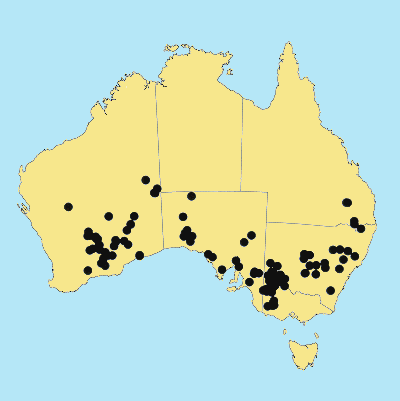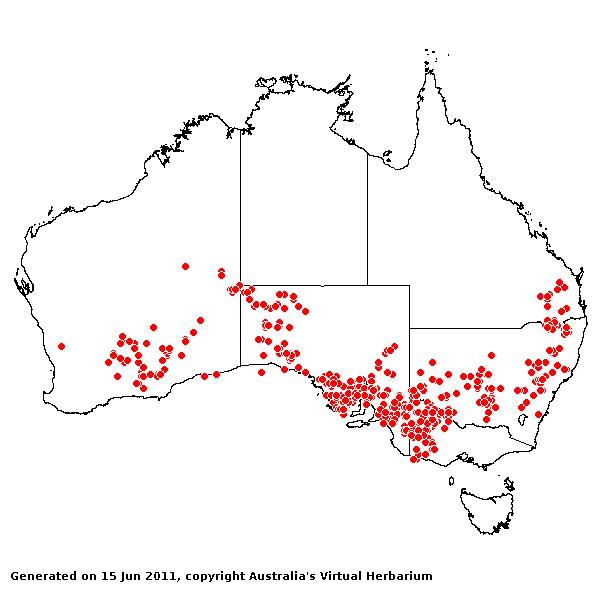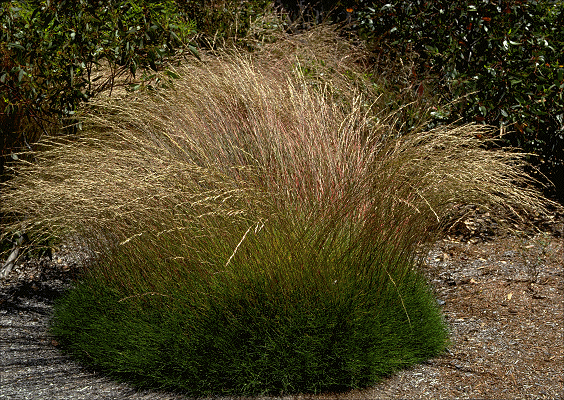Triodia scariosa N. T.
Burbidge. Austral.
J. Bot. 1: 173
(1953).
Classification. (GPWG 2001) : Subfamily
Chloridoideae. Triodeae.
Type of Basionym or
Protologue Information: Australia: Western Australia: Southern Hills,
Fraser Range, Cowan, N.T. Burbidge 2675 (HT: CANB).
Recent synonyms:
Triodia truncata.
Key references
(books and floras): [1981] M.Lazarides in J.Jessop (ed)., Flora of
Central Australia (446), [2002] D.Sharp & B.K.Simon, AusGrass,
Grasses of Australia, [2006] J.Jessop, G.R.M.Dashorst, F.M.James, Grasses
of South Australia (416), [2008] S.W.L.Jacobs, R.D.B.Walley &
D.J.B.Wheeler, Grasses of New South Wales (388).
Illustrations:
[2005] K.Mallet (ed.), Flora of Australia 44B: Poaceae 3 (Fig.
33D-E), [2006] J.Jessop, G.R.M.Dashorst, F.M.James, Grasses of South
Australia (417, Fig. 348), [2008]
S.W.L.Jacobs, R.D.B.Whalley & D.J.B.Wheeler, Grasses of New South Wales,
4th edn (388 as subsp scariosa and yelarbonensis).
Habit.
Perennial. Stolons present. Culms 30–100 cm tall. Leaf-sheath auricles absent.
Ligule a fringe of hairs. Leaf-blades straight, aciculate, conduplicate, 4–27
cm long, 0.7–2 mm wide.
Inflorescence.
Inflorescence compound, a panicle. Panicle linear, dense or loose, 7–46 cm
long, 1–3 cm wide.
Spikelets.
Spikelets pedicelled. Fertile spikelets many flowered, with at least 2 fertile
florets (4–9), comprising 4–9 fertile floret(s), with diminished florets at the
apex, linear or lanceolate, laterally compressed or terete, 5–23 mm long.
Glumes.
Glumes similar. Lower glume lanceolate, scarious or cartilaginous, without
keels, 3–5 -nerved. Lower glume surface glabrous. Lower glume apex muticous or
mucronate. Upper glume lanceolate, 5–11 mm long, scarious or cartilaginous,
without keels, 3–5 -nerved. Upper glume surface glabrous. Upper glume apex
entire, muticous.
Florets.
Fertile lemma 5–10 mm long, without keel or keeled, 3–9 -nerved. Lemma surface
indumented. Lemma apex erose or dentate or lobed, muticous or mucronate. Median
(principal) awn from a sinus, 1 mm long overall. Lodicules present. Anthers 3.
Continental
Distribution: Australasia.
Australian
Distribution: Western Australia, South Australia, Queensland, New South
Wales, Victoria.
Western Australia:
Carnegie, Helms, Austin. Irwin, Roe. South Australia: North-western,
Nullabor, Flinders Ranges, Eastern, Eyre Peninsula, Northern Lofty, Murray,
Yorke Peninsula, Southern Lofty, South-eastern. Queensland: Burnett,
Darling Downs. New South Wales: Central-Western Slopes, North-Western
Plains, South-Western Plains, North Far Western Plains, South Far Western
Plains. Victoria: Grampians, Lowan Mallee, Murray Mallee, Wannon,
Wimmera.
Notes.
Distinguished by its elongated, narrow panicles; loosely flowered, linear to
elliptical spikelets; 3–5-nerved, muticous, scarious or cartilaginous glumes
shorter than spikelet; lemmas hirsute, often thickly 3-nerved, emarginate or
minutely 2-lobed, muticous or mucronulate, truncate or obtuse.
S of
24°S in W.A., in S.A., Vic., N.S.W. (S of 30°S and W of 151°E), and in the
Burnett and Darling Downs Districts, Qld. Growing in a range of red, yellow or
brown, calcareous or clayey or siliceous sands or loams, on plateaux, flats,
ridges, gravelly rises, sandplains, dunes, interdunes, swales, or sandhills,
often in association with limestone, laterite and sometimes granite, and
sometimes in shallow soils on stony hillslopes of quartzite, sandstone and
other rocks; saline soils; coastal mallee; creek beds and banks; swamp margins;
flowers July-Apr.




